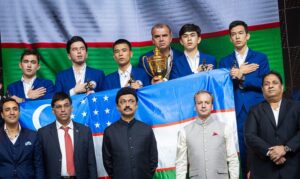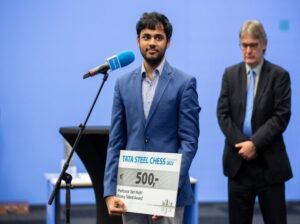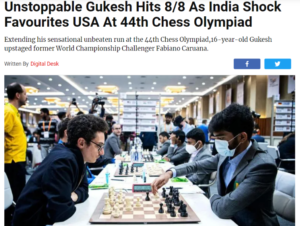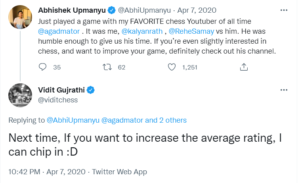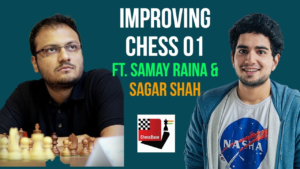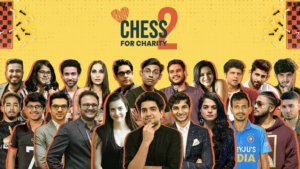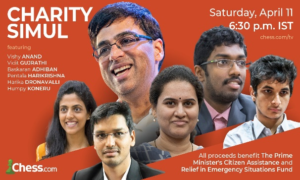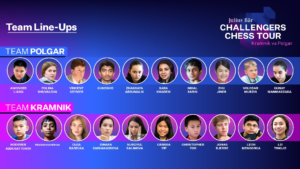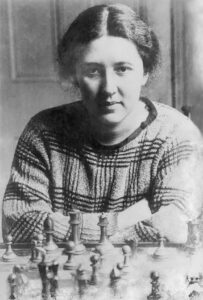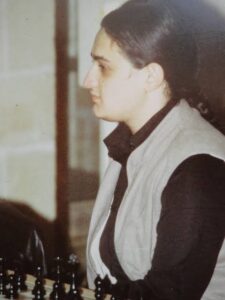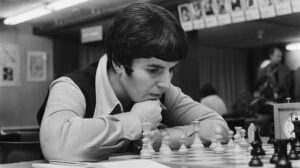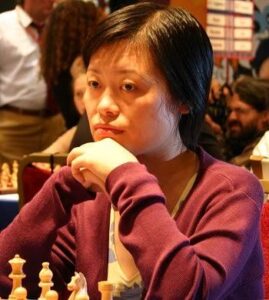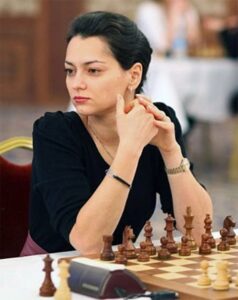CHESS GEN-Z
The 2022 Chess Olympiad created a storm in the world of chess with Uzbekistan winning the Gold Medal surpassing the highly experienced, top-seed, and season-favorite USA Team. A team consisting of young lads and top junior players outplayed their opponents and rose as underdogs. Another fantastic result was that of the India-2 team composed of 4 junior players, despite being lower rated than the India-1 team of the host country, the U-20 talent went on to fetch a bronze medal for their country.

Source: ChessBase India
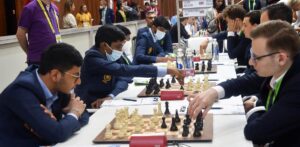
India Team 2 of youngsters in action at 44th Chess Olympiad. Source: The Hindu
Recent trends in chess are evident that the juniors are rising on various occasions against tough oppositions and proving the fact that the era of GEN-Z has begun! From World no.1 Junior, Alireza Firouzja winning the Sinquefield Cup and Grand Chess Tour’22, to young Indian GM Rameshbabu Praggnanandhaa getting the better of the World Champion Magnus Carlsen in multiple events, to GMs Nodirbek Abdusattorov and Raunak Sadhwani beating veterans like GMs Boris Gelfand and Veselin Topalov in recent Chess.com Global Chess Championship.



Amul India posts about Pragg winning against Carlsen
The results of the ongoing Julius Baer Generations Cup showcasing some exceptional junior talents against top players of the world is an example in itself of how the new generation is fearless and merciless when it comes to the game of 64 squares!

All juniors qualify for Semifinals in Julius Baer. Source: Chess24
But what is it which is favoring this bunch of prodigies? Is it just the age factor that gives them an edge?
Well, partly yes! A younger mind has been proven to retain memory better, which is one of the factors in the game of chess as it requires memorizing and visualizing multiple patterns and positions in games. But if we come to facts, at elite-level chess, almost every player irrespective of their age has a great memory.
However, there’s much more than meets the eye! One of the key reasons for the growth spurt in junior chess is the GLOBALIZATION of the game!! With the expansion of chess across nations and an increase in the number of organizations of various elite-level chess events across countries and platforms, these players have got the opportunity to play with Top players of the world from a very young age. For instance, Alireza Firouzja and Nihal Sarin had the chance of playing with Hikaru Nakamura multiple times in the year 2017-18, which helped them in shaping their game better and upskilling themselves. Events like the Champions Chess Tour and Chess.com Championships work like an ocean of exposure for young talents to face strong players across the globe!
While these opportunities are equally available for elite players of all ages, it is to be noted that the neuroplasticity of younger individuals favors them in performing better. Being exposed to tough opposition from a young age enables these juniors in training their minds at a higher level of chess, hence creating more chances of splendid performances. With an increase in quantity, comes an increase in quality as well. This strong competition has been one of the pivotal reasons why Alireza crossed 2800 elo at a young age and continues to be the top junior in chess since 2020

Source: Hikaru’s Twitter
Junior players like Arjun Erigaisi, Gukesh D, and Abdusattorov have been the recent additions to the 2700 club, but their journey towards it started long back when these players started to win back-to-back elite chess events and managed to crush many top players of the world. Nodirbek Abdusattarov, one of the most promising players of the young Uzbek team has defeated World Champion Magnus Carlsen along with notable players like Caruana and Aronian in the World Rapid and Blitz,2021 and continued his performance run in Classical games this year by defeating top players like Caruana, Gukesh D, and David Navara.

Credits: dw.com article

Source: chesscom

Arjun Erigaisi wins Tata Steel Chess Tournament. Source: WorldChess
While Arjun Erigaisi has won almost every tournament he has been a part of in recent times, his performances against elite players have been applauded by many in the chess world. He has outplayed opponents like Dominguez Perez, Wang Hao, Anton Guijarro, Esipenko, Shirov and has excellent performances in Rapid against Liem, Maghsoodloo, and Shankland.
Along with globalization, comes accessibility that adds to the luster of the gameplay of the young brigade. With an increase in global interconnections, it has become easy these days to access good tournaments with the availability of decent infrastructure. With a lot of chess tournaments available online and the training and coaching system shifting online, quality training and competition have become easily accessible to these kids from the beginning of their chess years, which has turned out to be a factor in their exponential growth.
Also, these kids have been born in the era of technology supercomputers. This makes it easy for them to train and get good at accessing chess openings and content from the constantly upgrading chess programs and engines instead of chess magazines and books.
The most surprising yet exciting quality of juniors is their “fearlessness”. Coach and Captain of the India-2 team at the Olympiad, GM R B Ramesh, in one of the press conferences pointed out the fact that the young guns do not fear facing anyone as their opponent on the board and are completely merciless as they are ready to take risks during their games because of their young age, unlike experienced players who choose to play safe at times due to their past experiences. This quality of having nerves of steel sometimes gives these youngsters a push to perform extraordinarily against higher-rated opponents.

Source: Republic World
While the future of chess looks bright and competitive with the presence of these juniors, it will be a delightful site to see some of these facing each other for the World Championship Title someday!

Source: Interview featured in The Week
By: Vidhi Karelia

